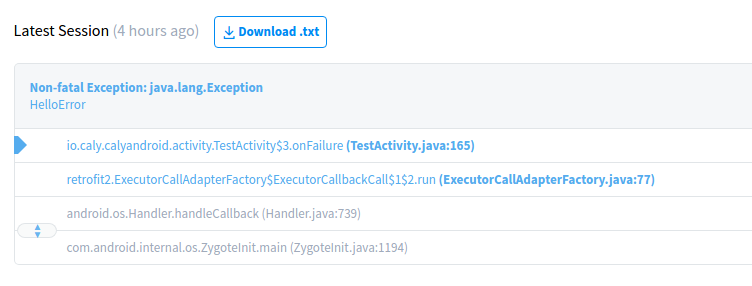fabric으로 에러 수집하기
fabric은 트위터가 만든 모바일 어플리케이션을 개발하면서 더 안정적으로 개발할 수 있도록 도와주는 모바일 플랫폼이다.
현재 Crashlytics, Answers, Appsee 등 여러 10개가 넘는 키트가 존재한다. 이번엔 가장 유명하고 쉽게 적용할 수 있는 Crashlytics를 적용해보자.
우선 fabric 사이트 에 들어가 가이드를 따라해보자
build.gradle에 fabric을 추가한다.
build.gradle
buildscript {
repositories {
maven { url 'https://maven.fabric.io/public' }
}
dependencies {
// These docs use an open ended version so that our plugin
// can be updated quickly in response to Android tooling updates
// We recommend changing it to the latest version from our changelog:
// https://docs.fabric.io/android/changelog.html#fabric-gradle-plugin
classpath 'io.fabric.tools:gradle:1.+'
}
}
apply plugin: 'com.android.application'
// Put Fabric plugin after Android plugin
apply plugin: 'io.fabric'
repositories {
maven { url 'https://maven.fabric.io/public' }
}
dependencies {
compile fileTree(dir: 'libs', include: ['*.jar'])
testCompile 'junit:junit:4.12'
compile 'com.android.support:appcompat-v7:23.1.1'
compile 'com.android.support:design:23.1.1'
compile('com.crashlytics.sdk.android:crashlytics:2.6.7@aar') {
transitive = true;
}
fabric 사이트에서 제공하는 API키를 받아와 AndroidManifest.xml에 추가한다.
<?xml version="1.0" encoding="utf-8"?>
<manifest xmlns:android="http://schemas.android.com/apk/res/android">
<application
android:allowBackup="true"
android:icon="@mipmap/ic_launcher"
android:label="@string/app_name"
android:theme="@style/AppTheme" >
<activity android:name=".MainActivity" android:label="@string/app_name" >
<intent-filter>
<action android:name="android.intent.action.MAIN" />
<category android:name="android.intent.category.LAUNCHER" />
</intent-filter>
</activity>
<meta-data
android:name="io.fabric.ApiKey"
android:value="API키를 여기 넣으면 되요!"
/>
</application>
<uses-permission android:name="android.permission.INTERNET" />
</manifest>
이제 Activity 혹은 Application에서 init해주기만 하면된다. 필자는 서비스나 리시버에서도 죽을 수 있기에 Application 레벨에서 생성해주고있다.
class CalyApplication extends Application {
@Override
public void onCreate() {
Logger.i(TAG, "onCreate");
super.onCreate();
init();
}
void init(){
//init fabric
Fabric.with(this, new Crashlytics());
}
}
이렇게만 하면 모든 준비가 됬다.(완전 편함!)
강제로 에러를 유도하는 간단한 코드를 만들어 fabric에서 확인해보자
TestActivity
public class TestActivity extends Activity{
@OnClick(R.id.btn_test_error)
public void onErrorClick()
{
throw new Exception("HelloError");
}
}
에러가 수집되면 바로 메일로 알려주고, 대시보드에 추가된다.(non fatal에러는 제외)

추가로 핸들링을 한 에러들에 대해 직접 로그를 남길수도 있다.
CustomException
class CustomException extends Exception{
public CustomException(String msg){
super(msg);
}
}
Activity
void writeFile(){
try{
//File IO
}
catch(Exception e){
Crashlytics.logException(new CustomException("io error"));
}
}

Comments